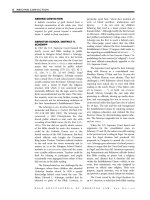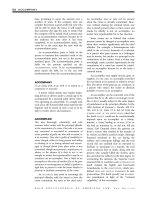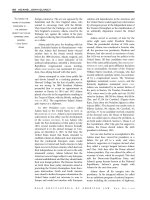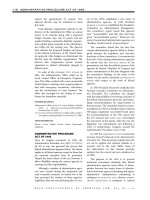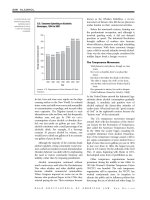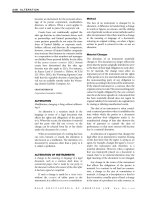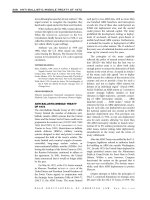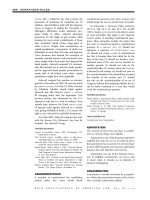Gale Encyclopedia Of American Law 3Rd Edition Volume 5 P33 ppsx
Bạn đang xem bản rút gọn của tài liệu. Xem và tải ngay bản đầy đủ của tài liệu tại đây (575.1 KB, 10 trang )
avoided conviction. In 1999 he was convicted of
second-degree murder following the nationally
televised broadcast of a videotape showing
Kevorkian injecting a lethal drug into a patient.
In 2000 the New England Journal of Medicine
revealed a study showing that 75 percent of the
69 Kevorkian-assisted deaths that were investi-
gated were of victims who were not suffering
from a potentially fatal disease; five had no
discernible disease at all. Instead, it appeared
that many of the suicides were the result of
depression or psychiatric disord er.
In 1997 Oregon was the first state to adopt a
statute permitting physician-assisted suicide.
Although the statute was a source of con-
siderable controversy, the U.S. Supreme Court
upheld the law in a 2006 decision. The Supreme
Court, in the case of Gonzales v. Oregon, did not
make any broad determinations with respect to
the right to die. Instead, the decision focused on
the government’s attempt to use the federal
Controlled Substances Act (CSA) to undermine
the Oregon law allowing for physician-assisted
suicide. The Supreme Court held that the
government could not use the CSA to prosecute
physicians that provide deadly doses of medicine
to terminally ill patients. In 2008 Washington
became the second state to establish a law
allowing for physician-assisted suicide.
FURTHER READINGS
Chan, Samantha. 2000. “Rates of Assisted Suicides Rise
Sharply in Oregon.” Student BMJ 11.
FAQs about the Death With Dignity Act. State of Oregon.
Available online at (accessed
June 10, 2009).
Garland, Norman M. 2009. Criminal Law for the Criminal
Justice Professional. 2nd Ed. New York: McGraw-Hill.
Kadish, Sanford H., ed. 1983. Encyclopedia of Crime and
Justice. Vol. 2. New York: Free Press.
Lafave, Wayne R., and Austin W. Scott, Jr. 1986. Substantive
Criminal Law. Vol. 2. St. Paul, MN: West.
Loewy, Arnold H. 2003. Criminal Law in a Nutshell. 4th Ed.
St. Paul, MN: West.
“New Revelations about Dr. Death.” 2000. Macleans 113.
Torcia, Charles E. 1994. Wharton’s Criminal Law. 15th ed.
New York: Clark, Boardman, Callaghan.
CROSS REFERENCES
Death and Dying; Insanity Def ense.
HONOR
As a verb, to accept a bill of exchange, or to pay a
note, check, or accepted bill, at maturity. To pay
or to accept and pay, or, where a credit so engages,
to purchase or discount a draft complying with
the terms of the draft.
As a noun, in old
ENGLISH LAW, a seigniory of
several manors held under one baron or lord
paramount. Also those dignities or privileges,
degrees of nobility, knighthood, and other titles
that flow from the crown.
In the United States, the customary title of
courtesy given to judges, and occasionally to
some other officers, as, “his honor,”“your honor,”
“honorable.”
HONORARY TRUST
An arrangement whereby property is placed in the
hands of another to be used for specific non-
charitable purposes where there is no definite
ascertainable beneficiary—one who profits by the
act of another—and that is unenforceable in the
absence of statute.
Trusts for the erection of monuments, the
care of graves, the saying of Masses, or the care
of specific animals, such as a cat, dog, or horse,
are examples of honorary trusts. Honorary
trusts for the benefit of specific animals differ
from charitable trusts that have as a trust
purpose the benefit of animals in general. In
many jurisdictions, legislation validates special
provisions for the upkeep of graves and
monuments. Similarly, trusts for the saying of
Masses are upheld as charitable t rusts.
As a general rule, the designated trustee, one
appointed or required by law to execute a trust,
can effectuate the intent of the settlor—one who
creates a trust—if he or she chooses to do so.
Since there is no beneficiary who can enforce the
trust, the implementation of the purposes of the
trust depends upon the honor of the trustee. If
the person does not execute the trust duties, he
or she holds the property for the settlor or the
settlor’s heirs on the theory of a
RESULTING TRUST.
Jurisdictions differ as to the extent to which
honorary trusts will be recognized, if at all.
Honorary trusts are usually limited by considera-
tions of public policy. For instance, they cannot
exist beyond the period of the
RULE AGAINST
PERPETUITIES
, and their amounts cannot be unrea-
sonably large for the purpose to be accomplished.
The purpose must also be that of a reasonably
normal testator and cannot be capricious.
A settlor bequeaths $1,000 to a trustee to care
for the settlor’scatanddog,and$1,000forthe
purpose of maintaining the settlor’shomeinthe
GALE ENCYCLOPEDIA OF AMERICAN LAW, 3RD E DITION
308 HONOR
same condition as of the instant of his death for
20 years thereafter, with all windows and doors
blocked shut. Upon the settlor’sdeath,the
residuary legatee inherits any money that remains
in the estate after all other claims are paid and
makes claims to both sums of money under these
testamentary provisions. A court will find that
the residuary legatee has no right to the $1,000
left for the cat and dog unless the trustee refuses
to fulfill the obligations of caring for the dog and
cat. The residuary legatee is, however, entitled to
the other $1,000. Neither of these provisions of
the settlor’s will created a private trust.
As a general rule, the beneficiary of a private
trust must be competent to come into court
either in person or by guardian and enforce the
trust duties against the trustee. Neither the cat
nor the dog can appear in court. Some states
permit provisions for reasonable sums to
specific animals to be valid honorary trusts as
long as public policy is not violated. If the
trustee fails to properly execute his or her duties,
he or she holds the property in resulting trust
for the heirs or
NEXT OF KIN of the decedent. In
this example, if the trustee spends the $1,000 in
caring for the dog and cat, he or she is not liable,
but if he or she does not, a court will order the
trustee to turn the money over to the residuary
legatee as the beneficiary of a resulting trust. If
the purpose of an intended honorary trust is
capricious, the trust will fail. In this case, there is
no legitimate end to be served by keeping the
settlor’s home boarded up for 20 years. The
purpose is capricious and the trust fails.
Therefore, the $1,000 set aside for this purpose
is held by the trustee in resulting trust for the
residuary legatee who must receive it.
v
HOOKS, BENJAMIN LAWSON
CIVIL RIGHTS advocate Benjamin Lawson Hooks is
best known as the forceful executive director of
the National Association for the Advancement
of Colored People (NAACP) from 1977 to 1993.
Before he led the NAACP, Hooks made a virtual
career out of shattering U.S. racial barriers. He
was the first African American ever appointed
to a Tennessee criminal court and the first
African American named to the
FEDERAL COM-
MUNICATIONS COMM ISSION
(FCC). Hooks was also
an ordained minister, a television host and
producer, a savings and loan administrator, a
public speaker, and a fast-food executive.
Hooks was born January 31, 1925, in
Memphis. As an African American living under
JIM CROW LAWS, he experienced the daily
Benjamin Lawson Hooks 1925–
▼▼
▼▼
1930
2000
1975
1950
◆◆
◆
◆
◆
◆
◆
◆❖
1925 Born,
Memphis, Tenn.
1939–45
World War II
1950–53
Korean War
1961–73
Vietnam War
1943 Drafted into
U.S. Army
1944 Earned B.A. from Howard University
1948 Received
doctor of
laws degree
from DePaul
University
1961–65 Served
as assistant public
defender of Shelby
County, Tenn.
1972 Appointed by President
Nixon as first African
American member of FCC
1965–68 Appointed first African
American judge on a Tenn. criminal
court (Shelby County Criminal Court)
1977–93 Served as
executive director of
NAACP
1998 Received National Civil Rights Museum
Freedom Award; named Distinguished Professor of
Political Science and History, University of Memphis
2007 Awarded
Presidential Medal
of Freedom
1993 Became senior vice president at the Chapman Company
1996 Benjamin L. Hooks Institute for
Social Change founded at University of Memphis
Benjamin Hooks.
CHIP SOMODEVILLA/
GETTY IMAGES
GALE ENCYCLOPEDIA OF AMERICAN LAW, 3RD E DITION
HOOKS, BENJAMIN LAWSON 309
indignities of southern segregation. His parents,
Bessie Hooks and Robert B. Hooks, raised their
seven children with high moral and academic
standards. After high school, Hooks enrolled at
LeMoyne College, in Memphis, but his college
career was interrupted by
WORLD WAR II. Hooks
was drafted into the U.S. Army in 1943 and rose
to the rank of staff sergeant.
After his military service, Hooks attended
Howard University, in Washington, D.C., and
graduated with a bachelor of arts degree in 1944.
Hooks then traveled to Chicago to study law at
DePaul University. Although Hooks wanted to
enroll in a Tennessee law school, he could not do
so because law schools in Tennessee refused to
admit African Americans. Hooks graduated with
adoctoroflawsdegreefromDePaulin1948.In
1949, he moved back to Memphis and started his
own law practice. In 1952, he married Frances
Dancy, and later, they had one child, Patricia.
During the 1950s Hooks became active in
the growing national
CIVIL RIGHTS MOVEMENT.
Along with
MARTIN LUTHER KING Jr., Hooks served
on the Board of Directors for the SOUTHERN
CHRISTIAN LEADERSHIP CONFERENCE
. During this
time, Hooks also became an ordained Baptist
minister and accepted a call as pastor of the
Middle Baptist Church in Memphis. Adding to
an already busy lif e, Hooks became vice
president of a savings and loan association he
helped found in Memphis in 1955.
In 1961 Hooks took over as assistant public
defender of Shelby County. His role led to an
appointment in 1965 by Governor Frank G.
Clement of Tennessee to the Shelby County
Criminal Court. With this appointment, Hooks
became the first African American to serve as
judge on the Tennessee criminal bench. In 1966
he was elected on his own to a full eight-year
term. In the meantime, Hooks became minister
of the Greater New Mount Moriah Baptist
Church in Detroit. He flew to Detroit twice a
month to lead his congregation.
In 1968 Hooks resigned his criminal court
judgeship to become president of Mahalia
Jackson Chicken Systems, a fast-food franchise.
In 1972, he was appointed by President
RICHARD
M
. NIXON to become a member of the previously
all-white FCC, the federal agency that licenses
and regulates radio, television, satellite com-
munications, telephones, and telegraph trans-
missions. This position allowed him to focus
public attention on the image of African
Americans in radio and television and to
increase minority jobs in broadcasting.
In 1977 Hooks assumed the position with
which he is most commonly identified: execu-
tive director of the NAACP. Following in the
footsteps of the retiring
ROY WILKINS, Hooks
accepted the job because he deeply respected the
NAACP and because he wanted to complete
some of the unfinished business of the equal
rights movement. A tireless worker, Hooks
spent long days in the NAACP Baltimore
headquarters performing what he called the
“killing job.”
During Hooks’s tenure the NAACP expressed
concern over homelessness, drug abuse, inade-
quate education, and neighborhood safety.
Hooks lamented the rise of an intractable urban
underclass and warned that the promise of
jobs and economic independence for African
Americans must be met soon.
Hooks’s important accomplishments with
the NAACP include his work in convincing
Congress to impose sanctions against South
Africa’s system of apartheid, for legislation
creating fair housing rights, and for a federally
recognized holiday to celebrate the life and
work of Martin Luther King Jr.
Hooks’s achievements with the NAACP
took on a special significance in view of the
political conservatism that prevailed during his
fifteen-year tenure as its head—a period when
RONALD REAGAN and GEORGE H. W. BUSH were in the
White House. Hooks vowed to keep the
NAACP true to its progressive mission. In fact,
under his leadership, the NAACP refused to
endorse the nomination of African American
CLARENCE THOMAS to the U.S. Supreme Court
because Thomas’s views were too conservative.
By the time Hooks retired from the NAACP
in 1993, its membership had grown to more than
500,000 people in over 2,200 chapters across the
United States. Hooks was gratified by the results
of a 1992 survey in which the NAACP earned an
86 percent approval rating among those polled.
The organization worked hard to counter
criticism that it was mired in the past and out
of touch with African American youths.
When Hooks retired from the NAACP post
in April 1993, the 64 members of the NAACP
Board of Directors elected Benjamin F. Chavis
Jr., as his successor. Hooks left the NAACP to
embark on yet another career challenge—as a
senior vice president at the Chapman Company,
a minority controlled brokerage and investment
banking firm with offices in seven cities.
THERE WILL ALWAYS
BE A NEED FOR THE
NAACP
.ONCE WE
THOUGHT THERE
WOULD COME A TIME
WHEN OUR WORK
WOULD BE FINISHED
.
B
UT RACISM STILL
EXISTS AND
INEQUALITY IS STILL
BUILT INTO THIS
SOCIETY
.
—BENJAMIN L. HOOKS
GALE ENCYCLOPEDIA OF AMERICAN LAW, 3RD E DITION
310 HOOKS, BENJAMIN LAWSON
The NAACP experienced turmoil in 1994
when a SEXUAL HARASSMENT lawsuit was filed
against Chavis. Chavis resigned and was replaced
in 1996 by Kweisi Mfume who functioned as
president and CEO. Throughout the controversy
Hooks remained supportive of the NAACP.
After retiring from the NAACP, Hooks
remained active. In addition to the Spingarn
Medal which he was awarded in 1986, Hooks
received n umerous awards and more than 25
honorary degrees, and he has served as president
of the National Civil Rights Museum. In 1996
the Benjamin L. Hooks Institute for Social
Change was established at the University of
Memphis. The purpose of the institute is to
promote understanding of the civil rights move-
ment and the quest for
HUMAN RIGHTS.Hooksalso
served as the chairman of the Board of Directors
of the National Civil Rights Museum.
In 2007 Hooks was awarded the Presidential
Medal of Freedom, the nation’s highest civilian
honor, by President
GEORGE W. BUSH. “Dr. Hooks
was a calm yet forceful voice for fairness,
opportunity,andpersonalresponsibility.He never
tired or falteredin demanding ournationlive up to
its founding ideals of liberty and equality,” said
Bush when he presented Hooks with the award.
Hooks died April 15, 2010, in his home in
Memphis, Tennessee.
FURTHER READINGS
“Benjamin Hooks, Leading Jurist and Civil Rights Leader.”
Voice of America. February 26, 2008.
Bigelow, Barbara Carlisle, ed. 1992. Contemporary Black
Biography. Vol. 2. Detroit: Gale Research.
Biography of Dr. Benjamin L. Hooks. Benjamin Hooks
Institute for Social Change. Available online at
(accessed
November 25, 2009).
Kluger, Richard. 1976. Simple Justice. New York: Random
House.
Orfield, Gary, Susan E. Eaton, and Elaine R. Jones. 1997.
Dismantling Desegregation: The Quiet Reversal of Brown
v. Board of Education. New York: New Press.
Schwartz, Bernard. 1986. Swann’s Way: The School Busing
Case and the Supreme Court. New York: Oxford
University Press.
v
HOOVER, HERBERT CLARK
Herbert Clark Hoover was the thirty-first
PRESIDENT OF THE UNITED STATES, serving from
1929 to 1932. A wealthy mining engineer,
Hoover directed humanitarian relief efforts
during and after World Wars I and II. His
presidency was devastated by the stock market
crash of 1929 and the ensuing Great Depression.
Hoover was born August 10, 1874, in West
Branch, Iowa. His father and mother died when
he was you ng, and he was raised by an uncle in
Oregon. He entered the first first-year class at
Stanford University and graduated in 1895
with a degree in mining engineering. He became
an expert on managing and reorganizing
mines throughout the world. He spent time in
Australia and China before setting up his own
engineering firm in London in 1908. By 1914
Hoover had become a millionaire.
Hoover became involved in relief work
during
WORLD WAR I. In 1914 he served as
director of the American Relief Commission in
England, which helped one hundred twenty
thousand U.S. citizens return home after being
stranded at the outbreak of the war. The British
government then asked him to lead the
Commission for Relief in Belgium. His main
achievement during this period was the distri-
bution of supplies to civilian victims of the war
in Belgium and France.
After the United States entered the war in
1917, President
WOODROW WILSON named
Hoover U.S. food administrator. In this capacity
Hoover coordinated the production and con-
servation of food supplies that could be used for
the war effort. Hoover also chaired the Europe-
an Relief and Reconstruction Commission,
directing activities of numerous relief depart-
ments and organizing the distribution of
provisions. After the war Hoover coordinated
the American Relief Administration. This agen-
cy provided food to millions during the famine
of 1921 in the Soviet Unio n.
Hoover’s humanitarian efforts made him an
international figure. Democrats and Republi-
cans sought to make him a presidential candi-
date in 1920, but Hoover rejected their offers.
Instead, in 1921 he accepted the position of
secretary of commerce in the administration of
President
WARREN G. HARDING, a Republican.
Hoover was an energetic administrator, reorga-
nizing the department and expanding its
oversight into commercial aviation, highway
safety, and radio broadcasting. He chaired
commissions that established the Hoover Dam
and the St. Lawrence Seaway.
In 1928 Hoover won the Republican
presidential nomination. He easily defeated
Democrat Alfred E. Smith, on a platform of
continued economic prosperity and support for
Prohibition.
FREE SPEECH DOES
NOT LIVE MANY
HOURS AFTER FREE
INDUSTRY AND FREE
COMMERCE DIE
.
—HERBERT HOOVER
GALE ENCYCLOPEDIA OF AMERICAN LAW, 3RD E DITION
HOOVER, HERBERT CLARK 311
Hoover devoted the early days of his
presidency to improving the economic condi-
tions of farmers. He advocated foreign tariffs on
imported farm products as a way to protect
domestic farm prices. Congress went beyond
Hoover’s recommendation and in 1930 enact ed
the Hawley-Smoot Tariff Act (19 U.S.C.A.
§ 1303 et seq.), which placed tariffs on nonfarm
products as well. The act severely damaged U.S.
foreign trade.
The control of Prohibition pursuant to the
EIGHTEENTH AMENDMENT and the VOLSTEAD ACT
(41 Stat. 305 [1919]) had become a serious
problem by 1929. ORGANIZED CRIME had seized
the opportunity to sell illegal alcohol. The only
way large-scale liquor and speakeasy traffic
could flourish was with the cooperation of law
enforcement, so state and local law enforcement
agencies were tainted with corruption. In 1929
Hoover established the National Commission
on Law Observance and Law Enforcement,
appointing
GEORGE W. WICKERSHAM to direct an
investigation of the effectiveness of law enforce-
ment practices in the United States. The
WICKERSHAM COMMISSION report was an important
inquiry into the practices of the U.S. criminal
justice system. The report examined all facets of
police work and, for the first time, discussed
police brutality and the “third degree” method
of interrogating suspects. The report called for
the professionalization of police.
The U.S. economy appeared to be robust in
1929, but a rising stock market had been built
on stock purchases financed by widespread
borrowing. When the stock market crash ed on
October 29, individuals, banks, and other
economic institutions were devastated. Hoover
sought to inspire public confidence by meeting
with business leaders and by proclaiming that
the economic downturn would be brief.
Hoover’s prediction was wrong. The United
States slid into the worst economic depression
in its history. Hoover resisted massive federal
intervention because he believed that the
economy would correct itself. He did approve
some federal public works projects that provided
jobs, but he opposed federal aid to the
Herbert Hoover.
LIBRARY OF CONGRESS
Herbert Clark Hoover 1874–1964
❖
1874 Born,
West Branch,
Iowa
◆
1908 Set up
engineering
firm in London,
England
◆
1895
Graduated
from Stanford
University
1934 The
Challenge
to Liberty
published
1932 Roosevelt won presidential
election in landslide
1914–18
World War I
1964 Died,
New York City
◆◆
1930 Hawley-Smoot Tariff Act passed
1939–45
World War II
1951–52
Memoirs published
1950–53
Korean War
1961–73
Vietnam War
▼▼
▼▼
19001900
18751875
19251925
19501950
19751975
◆
1914–21
Headed various
American and
European relief
agencies
❖
◆
1921 Appointed U.S. secretary of commerce
1929 Established Wickersham Commission
to investigate police corruption
1929–33 Served as president
of the United States
◆
◆
◆
1946 Appointed to head the
Famine Emergency Commission
1947 Hoover Commission proposed
changes to executive department
◆
1929 Stock market crashed, led to Great Depression
GALE ENCYCLOPEDIA OF AMERICAN LAW, 3RD E DITION
312 HOOVER, HERBERT CLARK
unemployed. In his view private charity should
help those who had fallen on hard times.
In 1932, with 12 million people out of work
and hundreds of banks faili ng, Hoover created
the Reconstruction Finance Corporation (RFC)
to extend loans to revitalize industry and to
keep bank s from going into
BANKRUPTCY. Con-
gress authorized the RFC to loan up to $300
million to states for relief. Many persons viewed
these actions as too little and too late.
The troubles of the Hoover administration
culminated in the Bonus Army March on
Washington, D.C. In 1932 World War I veterans
demanded monetary bonuses that had been
promised them in 1924, even though the
bonuses were not scheduled to be paid until
1945. The House of Representatives had passed a
bill authorizing early payment, and the veterans
sought to pressure the Senate to follow suit.
More than 15,000 veterans, in desperate need of
funds, organized a march on Washington, D.C.,
to secure immediate payment from the govern-
ment. The “bonus army” constructed a make-
shift city and declared that its members were
ready to stay until their goal was achieved.
Hoover dispatched federal troops to destroy the
encampment and drive the veterans out of the
nation’s capital. For doing so he received
nationwide criticism.
The
REPUBLICAN PARTY nominated Hoover
for a second term in 1932, but his candidacy
attracted little enthusiasm. The
DEMOCRATIC
PARTY
nominee, New York Governor FR AN KLI N
D
. ROOSEVELT, mounted a vigorous campaign
against Hoover’s economic policies, calling
for a “new deal” for U.S. citizens. Roosevelt
promised to balance the budget, provide
relief to the unemployed, he lp the farmer,
and repeal Prohibition. He carried 42 of the
48 states.
Hoover was angered by Roosevelt’s
NEW
DEAL
, which made the federal government the
dominant player in the national economy. In
1934 he published The Challenge to Liberty,
which attacked Roosevelt and his policies. He
then withdrew from public life until 1946, when
President
HARRY S . TRUMAN asked him to return
to relief work. Hoover subsequently directed the
Famine Emergency Commission, which distrib-
uted food supplies to war-torn nations. In 1947
Truman authorized him to investigate the
executive department of the U.S. government.
The resulting Hoover Commission proposed
changes in the
EXECUTIVE BRANCH that saved
money and streamlined government.
Hoover had a continuing interest in the
Hoover Institution on War, Revolution, and
Peace, which he founded at Stanford in 1919
and which remains an important research
center. He published his memoirs in three
volumes (1951–52) and The Ordeal of Woodrow
Wilson (1958).
Hoover lived longer after leaving the
presidency than did any other president. He
died at age 90 on October 20, 1964, in New
York City.
FURTHER READINGS
Hawley, Ellis, ed. 1974–1977. Herbert Hoover: Containing the
Public Messages, Speeches, and Statements of the Presi-
dent, 4 vols. Washington, D.C.: U.S. Government
Printing Office.
Leuchtenberg, William E. 2009. Herbert Hoover. New York:
Times.
Walch, Timothy, ed. 2003. Uncommon Americans: The Lives
and Legacies of Herbert and Lou Henry Hoover. Santa
Barbara, CA: Praeger.
v
HOOVER, JOHN EDGAR
John Edgar Hoover served from 1924 to 1972 as
the director of the
FEDERAL BUREAU OF INVESTIGA-
TION
(FBI). During his long tenure, Hoover
built the FBI into a formidable law enforcement
organization, establishing standards for the
collection and evaluation of information that
made the FBI an effective crime fighting agency.
However, Hoover’s reputation was tarnished by
his collection of damaging information on
prominent politicians and public figures for
his personal use, and by his aggressive investi-
gation of
CIVIL RIGHTS leaders and left-wing
radicals.
Hoover was born January 1, 1895, in
Washington, D.C. Following graduation from
high school, he turned down a scholarship from
the University of Virginia, electing to stay home
and study law at night at
GEORGE WASHINGTON
University. In 1916 he received a bachelor of
laws degree. In 1917 he added a master of laws
degree. Upon graduation from college, Hoover
joined the U.S.
JUSTICE DEPARTMENT.
Hoover started in a minor position, but his
intelligence, energy, and mastery of detail were
quickly noticed by his superiors. By 1919 he had
risen to the rank of special assistant attorney
general. During these early years, Hoover
first became involved with the suppression of
WE ARE A FACT-
GATHERING
ORGANIZATION ONLY
.
W
E DON’T CLEAR
ANYBODY
.WE DON’T
CONDEMN ANYBODY
.
—J. EDGAR HOOVER
GALE ENCYCLOPEDIA OF AMERICAN LAW, 3RD E DITION
HOOVER, JOHN EDGAR 313
political radicals, assisting Attorney General A.
Mitchell Palmer in the arrest and deportation of
left-wing aliens. In 1919 he was appointed chief
of the department ’s General Intelligence Divi-
sion (GID), a unit designated by Palmer to hunt
down radicals. Within three months Hoover
collected the names of 150,000 alleged sub-
versives. Armed with this information, federal
agents conducted nationwide dragnets, arresting
over ten thousand people. Critics argued that
these Palmer Raids violated civil liberties.
Nevertheless, thousands of persons were de-
ported. By 1921 the GID had nearly half a
million names of persons suspected of subver-
sive activities.
In 1924 Hoover was appointed acting
director of the Bureau of Investigation (BI),
the forerunner of the FBI. The BI was a weak
agency, hampered by limited investigatory
powers, the inability of its agents to carry
weapons, and the swelling of its rank with
political appointments. After several scandals
revealed the extent of the BI’s problems,
Attorney General
HARLAN F. STONE appointed
Hoover to clean up the agency.
Though only 29, Hoover met the challenge
head-on. He began a thoroug h reorganization
of the bureau, imposing strict discipline on his
employees. Hoover’s goal was to establish a
professional law enforcement agency of unques-
tioned integrity. Between 1924 and 1935, he
introduced a series of innovations that changed
national law enforcement. Hoover established a
national fingerprint collection, the first system-
atic database that federal, state, and local
agencies could use to match
FINGERPRINTS at
crime scenes with those on file at the bureau.
He also created a crime laboratory, which
developed scientific procedures for obtaining
forensic evidence. Finally, Hoover made a point
of changing the character of his agents. He
established a training academy for new agents,
who were selected on the basis of their
qualifications, not on their political connec-
tions. Agents were required to be college
educated and to maintain the highest standard
of personal and professional ethics.
As the agency became more professional, its
jurisdiction increased. In 1935 President
FRANKLIN
D
. ROOSEVELT signed crime bills giving agents the
authority to carry guns and make arrests, and in
the same year, the bureau officially became the
FBI. During the 1930s Hoover moved from
internal reorganization to external promotion of
himself and his agency. The gangster era, from
1920 to 1935, ended in the arrest or killing of
well-publicized hoodlums such as John Dillinger,
Pretty Boy Floyd, and Bonnie and Clyde. Hoover
and his G-men were celebrated for these exploits
in newspapers, radio, newsreels, and Hollywood
J. Edgar Hoover.
LIBRARY OF CONGRESS
John Edgar Hoover 1895–1972
❖
❖
1895 Born,
Washington, D.C.
1917 Earned LL.M. from George
Washington University;
joined Department of
Justice
1914–18
World War I
1961–73
Vietnam War
1939–45
World War II
1934 Bureau
agents gained
authority to
carry guns and
make arrests
1950–53
Korean War
▼▼
▼▼
19001900
19501950
19751975
19251925
1939 Supreme Court ruled
that the evidence from
illegal wiretaps could
not be used in trials
(Nardone v. United States)
◆◆
◆
◆◆
◆
1966
Freedom of
Information
Act passed
1924 Appointed
acting director
of the Bureau
of Investigation
(BI)
◆
1919 Appointed chief of the Justice
Department's General Intelligence Division
◆
1972 Died,
Washington,
D.C.
◆◆
1956
COINTELPRO
formed
1971
COINTELPRO
ended
1935 BI renamed FBI
1938 House Un-American Activities
Committee (HUAC) formed
GALE ENCYCLOPEDIA OF AMERICAN LAW, 3RD E DITION
314 HOOVER, JOHN EDGAR
movies, establishing Hoover as the nation’s
leading crime fighter.
Hoover’s focus shifted to political subversion
and foreign
ESPIONAGE during WORLD WAR II. Again,
the FBI was celebrated in the news media and
popular culture, this time for tracking down Nazi
saboteurs and spies. With the end of World War
II and the beginning of the
COLD WAR with the
Soviet Union, Hoover directed his efforts at
rooting out Communist subversives. Harkening
back to his early work with Palmer, Hoover’s
zealousness for this task led him to make
alliances with the House Un-American Activities
Committee; anti-Communist politicians such as
Representative
RICHARD M. NIXON,ofCalifornia,
and Senator
JOSEPH R. MCCARTHY, of Wisconsin;
and members of the news media who were eager
to print Hoover’s inside information.
During the 1950s Hoover concentrated on
anti-Communist initiatives, ignoring calls to
investigate the growth of
ORGANIZED CRIME.He
published Masters of Deceit (1958), a book that
articulated his views on what he perceived to be
the Communist conspiracy to overthrow the
U.S. government. He established the FBI’s Coun-
terintelligence Program (
COINTELPRO)todisrupt
the U.S. Communist party and to discredit its
members through informants, disinformation,
and anonymous letters and telephone calls. He
also enlisted the cooperation of the
INTERNAL
REVENUE SERVICE
to conduct selective tax audits of
people he suspected of being Communists.
Critics of Hoover argued—and continue to
argue—that he went beyond law enforcement
in these efforts, using so-called dirty tricks to
undermine the reputation of persons he believed
to be subversive.
Despite these charges Hoover remained a
powerful federal official. His use of wiretaps on
phones, and of other forms of
ELECTRONIC
SURVEILLANCE
, provided him with a wealth of
information on the private affairs of many
prominent political figures. Hoover shared some
of this information with his political allies, but
much of it remained in his private files. Over
time many politicians came to fear Hoover, who
they believed might have incriminating informa-
tion about them that could destroy their political
careers. Armed with these files, Hoover enjoyed
immense power in the 1950s and 1960s.
With the birth of the modern
CIVIL RIGHTS
MOVEMENT
, Hoover discovered what he consid-
ered another subversive group. He became
convinced that
MARTIN LUTHER KING, JR., was a
pawn of the Communist conspiracy. He had
agents follow King and record sexual encoun-
ters in various hotel rooms. King’s
SOUTHERN
CHRISTIAN LEADERSHIP CONFERENCE
offices were
wiretapped and burglarized by the FBI many
times, all in the hope of finding information
that would discredit King. Though Hoover’s
efforts proved futile, they demonstrated his
ability to use the FBI as his personal tool.
During the 1960s Hoover also had the FBI
investigate the
KU KLUX KLAN and other white
supremacist groups. The same techniques used
against King and other alleged subversives were
also employed against right-wing radicals who
threatened physical violence. And with the
growth of opposition to the
VIETNAM WAR in
the 1960s, Hoover targeted war protesters.
Presidents
LYNDON B. JOHNSON and Richard
M. Nixon allowed Hoover to serve past the
mandatory retirement age. During his last years,
Hoover was criticized for his authoritarian
administration of the FBI. Agents who dis-
pleased him could be banished to an obscure
FBI field office or discharged. Perhaps most
troubling was his refusal to investigate orga-
nized crime with the same resources expended
on politically subversive organizations.
Hoover died May 2, 1972, in Washington,
D.C.
FURTHER READINGS
Gentry, Curt. 2001. J. Edgar Hoover: The Man and the
Secrets. New York: Norton.
Powers, Richard G. 1987. Secrecy and Power: The Life of J.
Edgar Hoover. New York: Free Press.
Wannall, Ray. 2000. The Real J. Edgar Hoover: For the
Record. Paducah, KY: Turner.
CROSS REFERENCES
Communism; Forensic Science.
v
HORNBLOWER, WILLIAM BUTLER
William Butler Hornblower was a noted cor-
porate and trial lawyer who was nominated to
the U.S. Supreme Court but failed to win
confirmation.
Hornblower was born May 13, 1851, in
Paterson, New Jersey, with an unusually distin-
guished family background. His great-grandfather
was a member of the Congress of the
CONFEDERA-
TION
and a judge, his grandfather was a chief justice
of the Supreme Court of New Jersey, his father
was a noted theologian and pastor, and his mother
GALE ENCYCLOPEDIA OF AMERICAN LAW, 3RD E DITION
HORNBLOWER, WILLIAM BUTLER 315
was a descendant of Revolutionary leaders and
colonial judges. In addition, one of his uncles was
JOSEPH P. BRADLEY, an associate justice of the U.S.
Supreme Court, and another was Lewis
B. Woodruff, a highly respected federal
CIRCUIT
COURT
judge.
Hornblower was first educated at presti-
gious preparatory schools and in 1871 graduat-
ed with honors from the College of New Jersey
(later known as Princeton University). At the
encouragement of Bradley and Woodruff, he
then entered Columbia University to study law.
In 1875 he graduated with distinction, was
admitted to the bar, and became a trial lawyer
with the New York City firm of Caton and
Eaton, where he had been a clerk while a law
student. In 1888 he founded the firm of
Hornblower and Byrne. Throughout his legal
career, Hornblower represented a number of
major corporate clients, including the New
York Life Insurance Company; the Chicago,
Milwaukee, and St. Paul Railway Company; the
New York Security and Trust Company; and
several tobacco companies. He also served on
many public commissions, held office in state
and national bar associations, and was active in
the
DEMOCRATIC PARTY.
In 1893 President Grover Cleveland nomi-
nated Hornblower to succeed
SAMUEL BLATCHFORD,
who had died, as an associate justice of the U.S.
Supreme Court. Given his long and distin-
guished career, Hornblower appeared headed
for easy confirmation, but a bitter political
battle intervened to prevent H ornblower from
taking the seat.
A year before his nomination to the Court,
Hornblower had been appointed to a New York
City Bar Association committee convened to
investigate Judge Isaac H. Maynard. Maynard
was accused of improper conduct in a contested
election while he was deputy attorney general.
The investigation ultimately led to Maynard’s
defeat for a seat on the New York Court of
Appeals. David B. Hill, a powerful New York
senator and a close friend of Maynard’s,
retaliated against Hornblower for his role in
the investigation by vigorously campaigning
against Hornblower’s nomination. Hill’s efforts
were successful: the Senate rejected Horn-
blower’s nomination by a vote of 30–24.
In 1895 President Cleveland nominated
Hornblower for another vacancy on the Court.
This time, Hornblower declined the nomina-
tion, citing the financial sacrifice he would incur
if he left his very lucrative law practice.
In 1914 Hornblower was nominated to the
New York Court of Appeals and was confirmed
unanimously by the New York state senate. He
took his seat on the court in March, but left
after only one week owing to illness. He died
two months later, on June 16, 1914, in
Litchfield, Connecticut.
HORNBOOK
A primer; a book explaining the basics, funda-
mentals, or rudiments of any science or branch of
knowledge. The phrase hornbook law is a
colloquial designation of the rudiments or general
principles of law.
A colloquial reference to a series of textbooks
that review various fields of law in sum mary,
narrative form, as opposed to casebooks, which are
designed as primary teaching tools and include
many reprints of court opinions.
William Butler Hornblower 1851–1914
❖
◆◆
1851 Born,
Paterson, N.J.
1914–18
World War I
1914 Appointed to
New York Court of
Appeals; died,
Litchfield, Conn.
1861–65
U.S. Civil War
1893 Nominated to
Supreme Court by President
Cleveland but failed to win
confirmation
▼▼
▼▼
19001900
19251925
18501850
18751875
❖
◆
1871
Graduated
with honors
from Princeton
University
◆
1875 Graduated
from Columbia
University Law
School; admitted
to New York bar
1888 Founded law
firm of Hornblower
and Byrne
◆
1895 Declined
second
nomination to
Supreme Court
[T]HE INDEPENDENCE
OF THE
JUDICIARY IS
THE KEYSTONE OF
OUR FORM OF
GOVERNMENT
, THAT
IF THE KEYSTONE IS
REMOVED THE WHOLE
STRUCTURE IS IN
DANGER OF
DISINTEGRATION AND
DESTRUCTION
.
—WILLIAM
HORNBLOWER
GALE ENCYCLOPEDIA OF AMERICAN LAW, 3RD E DITION
316 HORNBOOK
HOSTAGES
Persons taken by an individual or organized group
in order to force a state, government unit, or
community to meet certain conditions: payment of
ransom, release of prisoners, or some other act.
The taking of hostages, whether during
wartime or periods of peace, is generally con-
demned under
INTERNATIONAL LAW.
HOSTILE FIRE
In insurance law, a combustion that cannot be
controlled, that escapes from where it was initially
set and confined, or one that was not intended to
exist.
A hostile fire differs from a
FRIENDLY FIRE,
which burns in a place where it was intended to
burn, such as one confined to a fireplace or
furnace.
HOSTILE WITNESS
A witness at a trial who is so adverse to the
party that called him or her that he or she can be
cross-examined as though called to testify by the
opposing party.
The
FEDERAL RULES OF EVIDENCE provide that
witnesses who are hostile, or adverse, can be in-
terrogated through the use of leading questions.
HOT LINE AGREEMENT, 1971
The original “hot line” agreement was a
memorandum of understanding between the
United States and the Soviet Union reached in
1963 to establish a direct communications link
between the governments of the two nations.
The need for such a communications
channel was evident in the
CUBAN MISSILE CRISIS
of 1962 and its establishment was viewed as a
means of forestalling an unnecessary resort to
force. The 1971 hot line agreement updated the
1963 accord by increasing the communications
capability between the two governments. It
called for the addition of two separate circuits
of commun ications employing a U.S. and a
Russian satellite system.
CROSS REFERENCE
Cold War.
HOT PURSUIT
A doctrine that provides that the police may enter
the premises where they suspect a crime has been
committed without a warrant when delay would
endanger their lives or the lives of others and
lead to the escape of the alleged perpetrator; also
sometimes called fresh pursuit.
Countless crime dramas have portraye d
police officers in a high-speed chase barking
into their radio that they are “in hot pursuit” of
a suspect. This popular image says little about
the legal rule of hot pursuit. As established
by the U.S. Supreme Court, the rule is an
important exception to the freedoms guaran-
teed by the
FOURTH AMENDMENT. That constitu-
tional provision safeguards citizens against
excessive police intrusion into their life and
property. Its foremost protection is the
SEARCH
WARRANT
, which must be obtained from a judge
or magistrate before the police can condu ct
most searches. Under special circumstances, the
rule of hot pursuit gives the police extra powers
to enter private property and conduct a search
without a warrant. The rule recognizes practical
limitations on Fourth Amendment rights in
light of the realities of police work, especially in
emergencies, but it stops far short of giving the
police complete freedom to conduct warrantless
searches.
As a powerful deterrent to the
ABUSE OF
POWER
, the Fourth Amendment is designe d to
The doctrine of hot
pursuit provides that
in certain cases police
may enter, without a
warrant, premises
where they suspect a
crime has been
committed.
CORBIS.
GALE ENCYCLOPEDIA OF AMERICAN LAW, 3
RD E DITION
HOT PURSUIT 317
